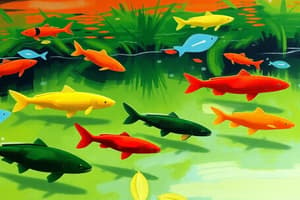Podcast
Questions and Answers
What does water quality refer to?
What does water quality refer to?
- Chemical factors only
- Only the physical factors of water
- Biological factors only
- All factors influencing the use of water (correct)
Euryhaline organisms can only tolerate a narrow range of salinity.
Euryhaline organisms can only tolerate a narrow range of salinity.
False (B)
What effect does a high level of carbon dioxide have on water pH?
What effect does a high level of carbon dioxide have on water pH?
It makes water more acidic.
Salinity is expressed in terms of weight of salts per volume of water, usually in parts per _____ (ppt).
Salinity is expressed in terms of weight of salts per volume of water, usually in parts per _____ (ppt).
Match the water parameters with their correct descriptions:
Match the water parameters with their correct descriptions:
Which method can be used to measure pH?
Which method can be used to measure pH?
More than 2 ppm of dissolved oxygen is typically safe for fish.
More than 2 ppm of dissolved oxygen is typically safe for fish.
Name two essential nutrients mentioned in water quality parameters.
Name two essential nutrients mentioned in water quality parameters.
Low levels of dissolved oxygen can cause _____ in fish due to asphyxiation.
Low levels of dissolved oxygen can cause _____ in fish due to asphyxiation.
What is the consequence of too much dissolved oxygen in water?
What is the consequence of too much dissolved oxygen in water?
Flashcards are hidden until you start studying
Study Notes
Water Quality Overview
- Water quality refers to physical, chemical, and biological factors influencing water use.
- In aquaculture, water quality is crucial for site selection, species cultured, and optimal rearing conditions.
Major Water Parameters
- Key parameters include pH, alkalinity, salinity, dissolved oxygen, temperature, nitrogen, and phosphorus.
pH
- pH is a logarithmic scale indicating solution acidity, related to hydrogen ion concentration (H+).
- Affects blood's oxygen-carrying capacity and fluctuates daily due to carbon dioxide levels in water.
- Higher CO2 increases acidity, impacting photosynthesis in aquatic systems.
- pH measurements can be conducted using pH meters or pH paper.
Salinity
- Salinity measures the total salts in water, expressed in parts per thousand (ppt).
- Variations can induce stress and mortality in fish; euryhaline organisms tolerate a wide salinity range, while stenohaline species can only withstand narrow variations.
- Measured using conductivity probes, hydrometers, or refractometers.
Dissolved Oxygen (DO)
- Dissolved oxygen is essential for respiration in aquatic organisms.
- Low levels (< 2 ppm) can lead to stress and death in fish due to asphyxiation.
- Excessive DO can cause gas embolisms, also known as gas bubble disease.
- Measurements of dissolved oxygen are crucial for maintaining aquaculture health.
Studying That Suits You
Use AI to generate personalized quizzes and flashcards to suit your learning preferences.




